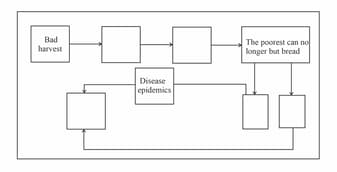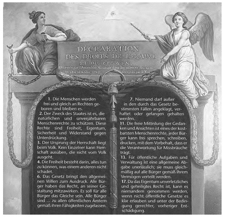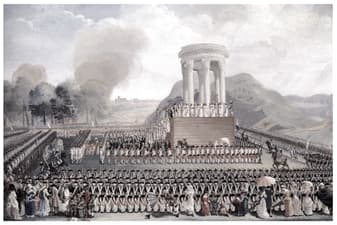How would you explain the rise of Napoleon?

Important Questions on The French Revolution
Fill in the boxes in the given image with appropriate terms from among the following:
Food riots, scarcity of grain, increased number of deaths, rising food prices, weaker bodies.

Identify the symbols in the image which stand for liberty, equality and fraternity.








Explain the meaning of the painting of the Declaration of Rights of Man and Citizen in the image given by reading the symbols.

The revolutionary journalist Jean-Paul Marat commented in his newspaper L’Ami du Peuple (The friend of the people) on the Constitution drafted by the National Assembly: ‘The task of representing the people has been given to the rich … the lot of the poor and oppressed will never be improved by peaceful means alone. Here we have absolute proof of how wealth influences the law. Yet, laws will last only as long as the people agree to obey them. And when they have managed to cast off the yoke of the aristocrats, they will do the same to the other owners of wealth.’ Source: An extract from the newspaper L’Ami du Peuple.
Read the paragraph given above and answer the following:
1. Which groups of French society would have gained from the Constitution?
2. Which groups would have had reason to be dissatisfied? What developments does Marat anticipate in the future?
Imagine the impact of the events in France on neighbouring countries such as Prussia, Austria-Hungary or Spain, all of which were absolute monarchies. How would the kings, traders, peasants, nobles or members of the clergy here have reacted to the news of what was happening in France?
Look carefully at the painting and identify the objects which are political symbols. (broken chain, red cap, faces, Charter of the Declaration of Rights).
The pyramid stands for equality, often represented by a triangle. Use the symbols to interpret the painting.
Describe your impressions of the female figure of liberty.

The Declaration of Rights of Man and Citizen
- Men are born and remain free and equal in rights
- The aim of every political association is the preservation of the natural and inalienable rights of man; these are liberty, property, security and resistance to oppression
- The source of all sovereignty resides in the nation; no group or individual may exercise authority that does not come from the people
- Liberty consists of the power to do whatever is not injurious to others
- The law has the right to forbid only actions that are injurious to society
- Law is the expression of the general will. All citizens have the right to participate in its formation, personally or through their representatives. All citizens are equal before it
- No man may be accused, arrested or detained, except in cases determined by the law
- Every citizen may speak, write and print freely; he must take responsibility for the abuse of such liberty in cases determined by the law
- For the maintenance of the public force and for the expenses of administration, a common tax is indispensable; it must be assessed equally on all citizens in proportion to their means
- Since the property is a sacred and inviolable right, no one may be deprived of it, unless a legally established public necessity requires it. In that case, just compensation must be given in advance
Refer to Source given above and compare the views of Desmoulins and Robespierre and answer the following questions.
1. How does each one understand the use of state force? What does Robespierre mean by ‘the war of liberty against tyranny?
2. How does Desmoulins perceive liberty? What did the constitutional laws on the rights of individuals lay down? Discuss your views on the subject in class.

The revolutionary government sought to mobilise the loyalty of its subjects through various means –one of them was the staging of festivals like this one. Symbols from civilisations of Ancient Greece and Rome were used to convey the aura of a hallowed history. The pavilion on the raised platform in the middle carried by classical columns was made of perishable material that could be dismantled.
Describe the groups of people, their clothes, their roles and actions. What impression of a revolutionary festival does this image convey.
